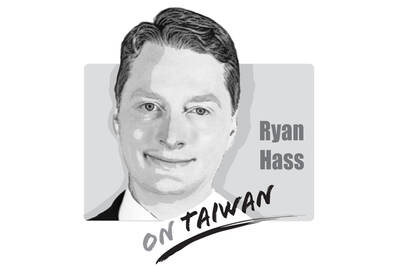After reading the article by Hideki Nagayama [English version on same page] published in the Liberty Times (sister newspaper of the Taipei Times) on Wednesday, I decided to write this article in hopes of ever so slightly easing my depression.
In August, I visited the National Museum of Ethnology in Osaka, Japan, to attend a seminar. While there, I had the chance to look at the museum’s collections. I felt extreme annoyance at seeing that the museum had classified Taiwanese indigenous peoples as part of China’s ethnic minorities. I kept thinking about how I could make this known, but after returning to Taiwan, I became quite busy with my duties at the start of the school term and was forced to set my annoyance aside.
The museum’s exhibit about Taiwanese indigenous groups undoubtedly reflects its stance on concealing reality, further illustrating that its curators are completely detached from the ideological trends of the international community.
The term “indigenous peoples” is used extensively throughout the world and is distinct from the term “ethnic minorities.” Therefore, the International Council for Traditions of Music and Dance, supported by the UN Educational, Scientific and Cultural Organization (UNESCO), has separate study groups for “Indigenous Music and Dance” and “Music and Minorities.”
In a report submitted to the UN in 1987, Jose R. Martinez Cobo proposed a definition for indigenous peoples that has since been revised and supplemented by scholars. Currently, indigenous peoples are defined internationally as those who live in and have a “strong link” to their ancestral lands, but became marginalized under colonization. They have “languages, cultures, beliefs, and knowledge systems” that are distinct from those of their colonizers.
From this, we can understand that having lived under the rule of colonizers is a prerequisite to being classified as indigenous. Taiwanese indigenous peoples have never lived under the rule of the People’s Republic of China — not even for a single day. They cannot even be considered Chinese indigenous people, let alone part of China’s ethnic minorities.
Although not all Chinese ethnic minorities were necessarily colonized by Han Chinese, the two groups have a long history of cultural exchange. In contrast, Taiwanese indigenous peoples have only had a maximum of 400 years of contact with Han Chinese.
Present-day Taiwanese indigenous peoples have been somewhat influenced by Han Chinese, but their Austronesian languages and culture are distinctly different. Therefore, from an academic perspective, it is groundless to define Taiwanese indigenous peoples as part of China’s ethnic minorities.
The National Museum of Ethnology was established during the 1970 Japan World Exposition held in Osaka. At that time, research on indigenous peoples had not yet been popularized and the international community believed indigenous people would eventually disappear.
In the 21st century, not only have indigenous people not disappeared, but their presence has led to what anthropologist Marshall Sahlins calls “anthropological enlightenment.”
The National Museum of Ethnology was founded more than 50 years ago. Throughout the past half-century, the international perception of museums has undergone significant changes — museums are no longer places for the top-down education of the public.
The 2025 Expo is to be held in Osaka once again. On this occasion, I sincerely hope that the National Museum of Ethnology can keep up with the times. Reclassifying Taiwanese indigenous peoples is the first step on the road to change.
Chen Chun-bin is a professor at Taipei National University of the Arts.
Translated by Kyra Gustavsen
When US budget carrier Southwest Airlines last week announced a new partnership with China Airlines, Southwest’s social media were filled with comments from travelers excited by the new opportunity to visit China. Of course, China Airlines is not based in China, but in Taiwan, and the new partnership connects Taiwan Taoyuan International Airport with 30 cities across the US. At a time when China is increasing efforts on all fronts to falsely label Taiwan as “China” in all arenas, Taiwan does itself no favors by having its flagship carrier named China Airlines. The Ministry of Foreign Affairs is eager to jump at
The muting of the line “I’m from Taiwan” (我台灣來欸), sung in Hoklo (commonly known as Taiwanese), during a performance at the closing ceremony of the World Masters Games in New Taipei City on May 31 has sparked a public outcry. The lyric from the well-known song All Eyes on Me (世界都看見) — originally written and performed by Taiwanese hip-hop group Nine One One (玖壹壹) — was muted twice, while the subtitles on the screen showed an alternate line, “we come here together” (阮作伙來欸), which was not sung. The song, performed at the ceremony by a cheerleading group, was the theme

Secretary of State Marco Rubio raised eyebrows recently when he declared the era of American unipolarity over. He described America’s unrivaled dominance of the international system as an anomaly that was created by the collapse of the Soviet Union at the end of the Cold War. Now, he observed, the United States was returning to a more multipolar world where there are great powers in different parts of the planet. He pointed to China and Russia, as well as “rogue states like Iran and North Korea” as examples of countries the United States must contend with. This all begs the question:

Liberals have wasted no time in pointing to Karol Nawrocki’s lack of qualifications for his new job as president of Poland. He has never previously held political office. He won by the narrowest of margins, with 50.9 percent of the vote. However, Nawrocki possesses the one qualification that many national populists value above all other: a taste for physical strength laced with violence. Nawrocki is a former boxer who still likes to go a few rounds. He is also such an enthusiastic soccer supporter that he reportedly got the logos of his two favorite teams — Chelsea and Lechia Gdansk —